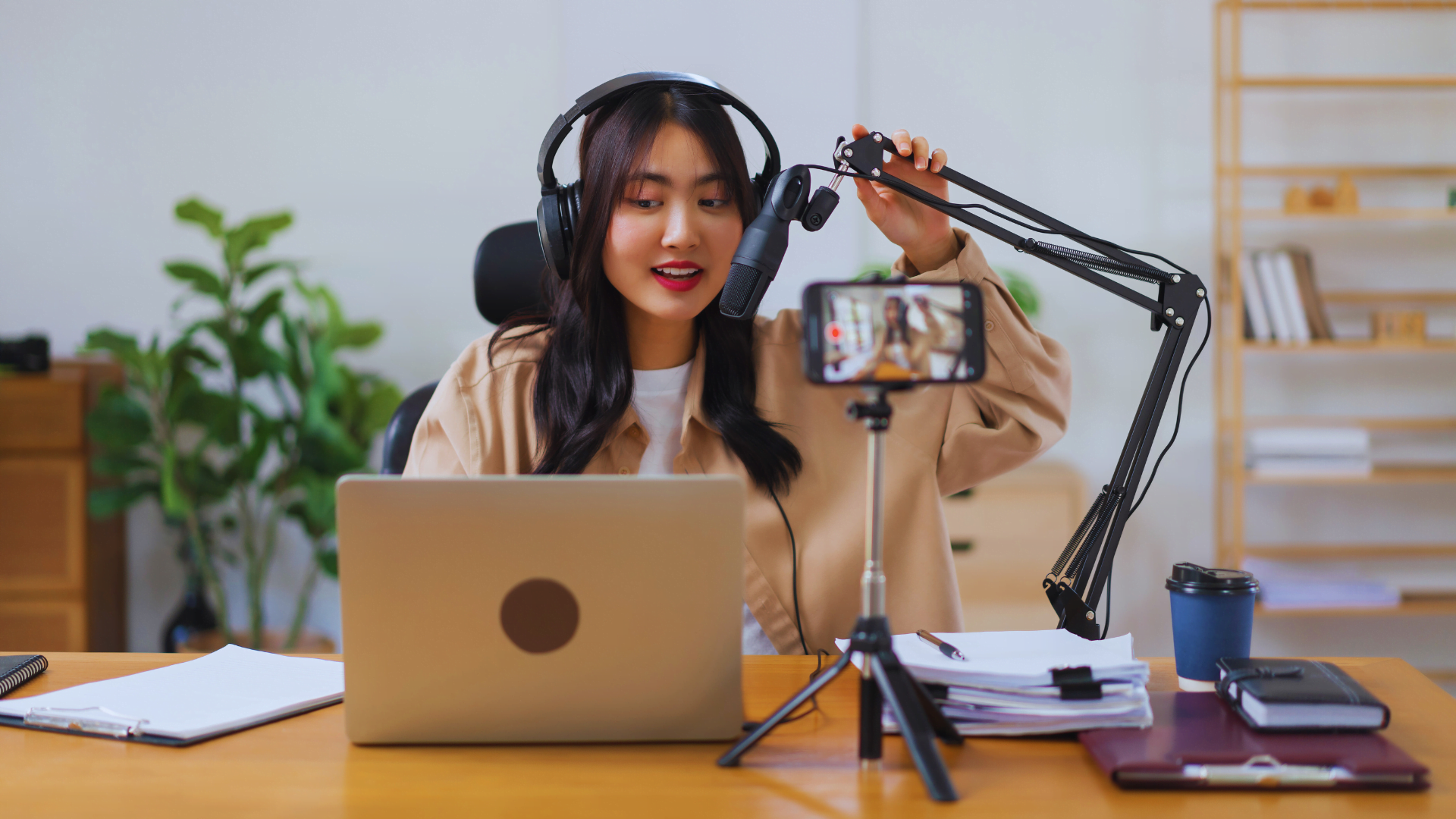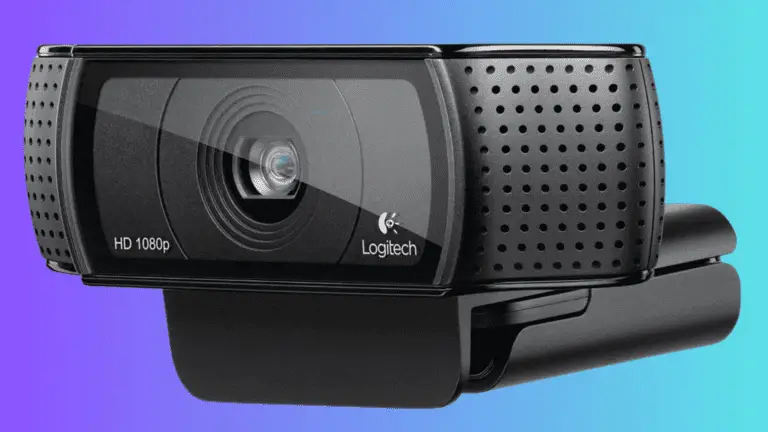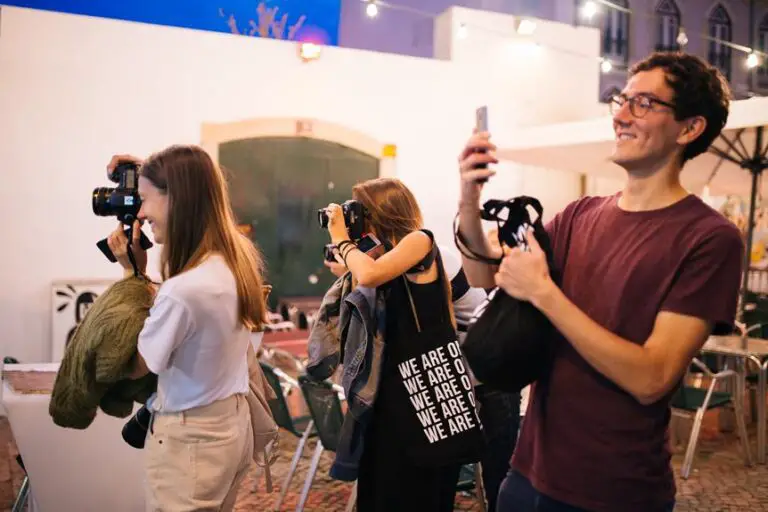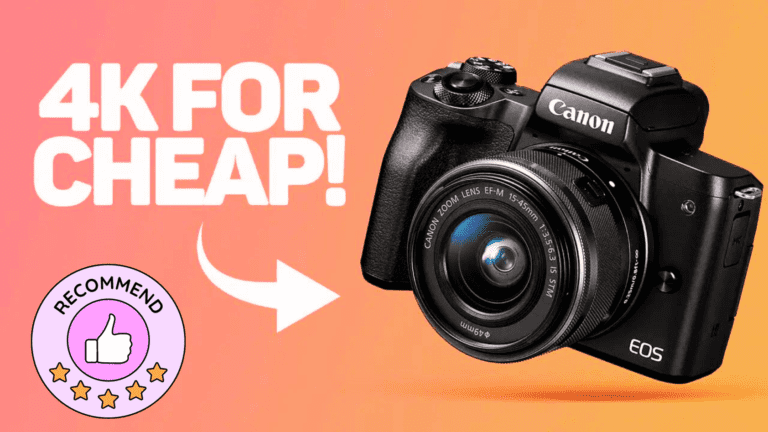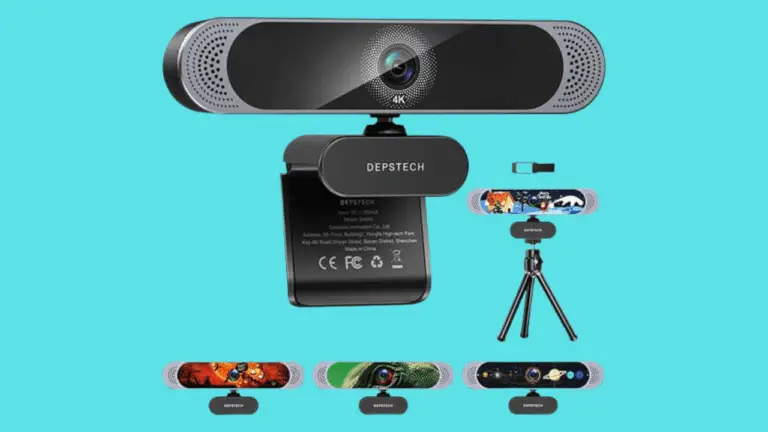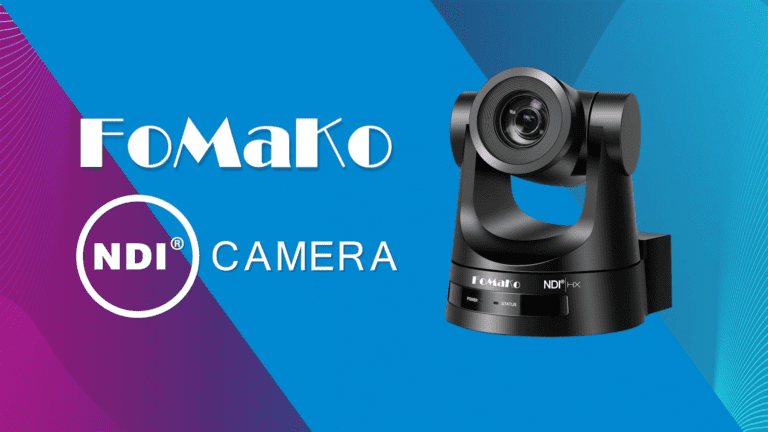Did you know that 60% of podcast listeners also watch video podcasts?
If you’re looking to step up your podcast game and engage your audience visually, choosing the right camera is crucial. In this article, we’ve rounded up the 11 best cameras for podcasting.
We’ll also share what you should consider before making a purchase.
Let’s dive in and find the perfect camera to take your podcast to the next level.
Key Takeaways
- The Canon EOS R6 Mark II is a top choice for podcasting with its high-resolution sensor, advanced image processor, and uncropped 4K video capabilities.
- The Panasonic LUMIX G100 offers a lightweight design, 4K photo and video quality, smartphone integration, and a built-in microphone, making it a great option for podcasters on the go.
- The Sony ZV-E10 is a versatile camera with an APS-C sensor, integrated directional mic, flip-out touchscreen LCD, and a fast hybrid AF system, providing excellent performance for podcasting.
- Good audio quality is important for podcasting, and cameras like the Canon EOS 80D, Panasonic Lumix GH5, Blackmagic Pocket Cinema Camera 4K, and GoPro Hero 9 Black (with optional external microphone input) are recommended for capturing clear and crisp audio.
10 Best Cameras for Podcasting
Let’s talk about the best cameras for podcasting.
We’ve got a few top contenders on our list, including the Canon EOS R6 Mark II, Canon VIXIA HF G50, Panasonic LUMIX G100, Canon EOS Rebel T7, and Panasonic HC-VX981K.
Each of these cameras offers unique features and capabilities that make them great options for capturing high-quality video and audio for your podcast.
Canon EOS R6 Mark II: Best Professional Camera
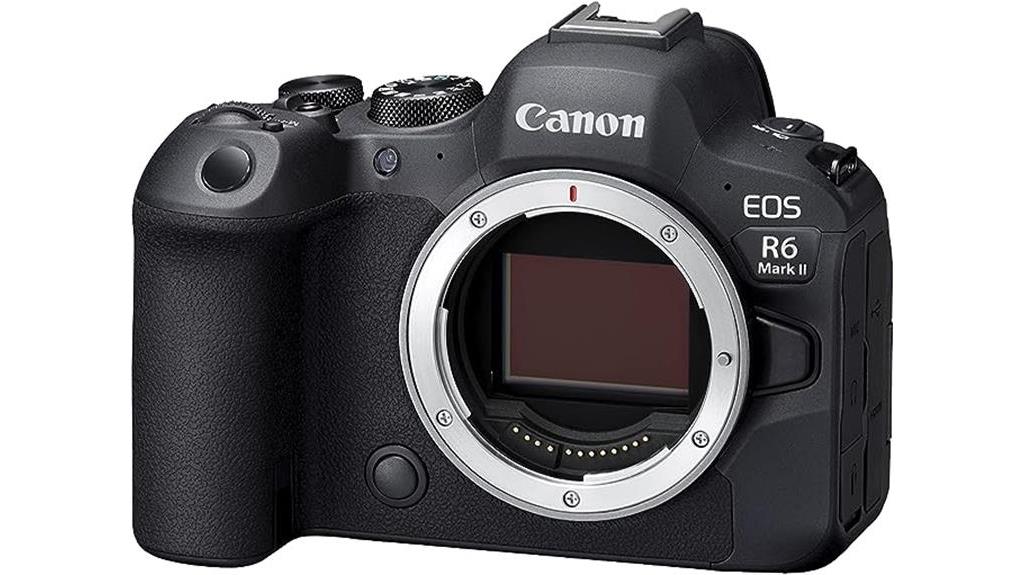
We highly recommend the Canon EOS R6 Mark II for podcasting due to its advanced features and exceptional performance. This full-frame mirrorless camera is equipped with a 24.2MP CMOS sensor and a DIGIC X image processor, allowing for high-resolution and noise-free images. With its high-speed continuous shooting capability of up to 40 fps at 20MP, you can effortlessly capture dynamic action shots. The improved subject detection feature includes accurate detection of people, animals, cars, motorcycles, horses, trains, and aircraft. Additionally, the advanced head, face, and eye detection ensure optimal focus and image quality.
The camera also offers 6K oversampled uncropped 4K video recording at up to 60 fps, making it perfect for podcasters who want to create professional-quality videos.
Product Specs:
- 24.2MP full-frame CMOS sensor
- DIGIC X image processor
- High-speed continuous shooting up to 40 fps at 20MP
- Improved subject detection including people, animals, cars, motorcycles, horses, trains, and aircraft
- Advanced head, face, and eye detection
- 6K oversampled uncropped 4K video recording at up to 60 fps
- 5GHz Wi-Fi and Bluetooth 5 connectivity
Pros:
- Exceptional image quality and low noise
- Accurate autofocus system
- High-speed continuous shooting for capturing action shots
- Advanced subject detection for various subjects
- 6K oversampled uncropped 4K video recording
- Seamless smartphone connectivity for easy sharing
Cons:
- Viewfinder flickering issues reported by some users
- Some users experienced focusing issues
- Limited battery life for continuous shooting
Canon VIXIA HF G50: Best Podcast Camera
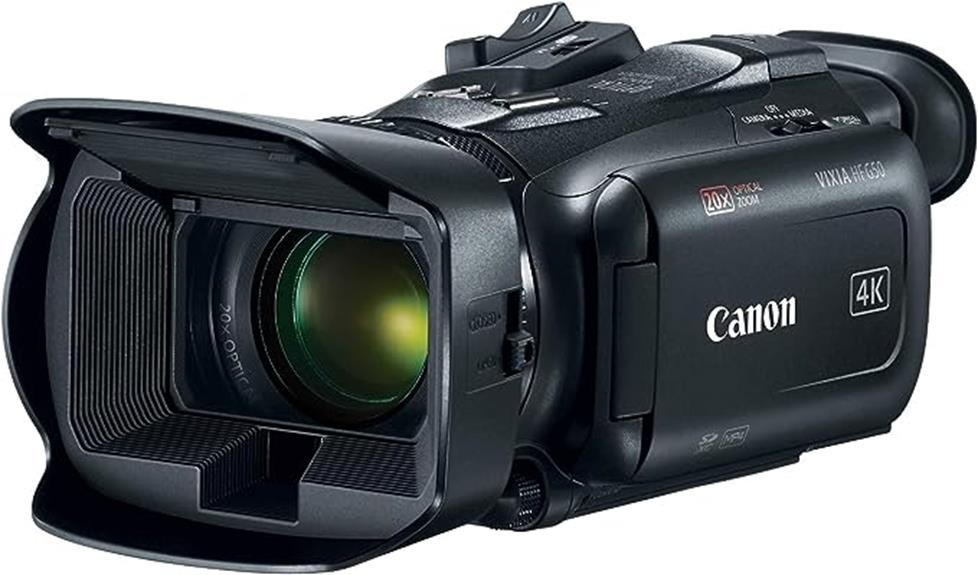
The Canon VIXIA HF G50 is an excellent choice for podcasting with its impressive 4K recording capabilities and advanced image stabilization. With its large-format CMOS Sensor and DIGIC DV 6 Image Processor, this camera delivers brilliant results on any screen. The 20x Optical Zoom lens provides impressive telephoto power and a wide angle of view, allowing you to capture every detail. The 5-axis Image Stabilization system ensures steady and focused footage, eliminating any shakiness. Additionally, the camera can be used for continuous recording for more than 24 hours with two 256GB memory cards, making it perfect for long podcasting sessions.
Product Specs:
- Product Dimensions: 9.1 x 4.5 x 3.3 inches
- Item Weight: 1.25 pounds
- ASIN: B07MLBD875
- Item model number: 3667C002
- Batteries: 1 Lithium Ion batteries required. (included)
- Video capture resolution: 1080p
Pros:
- Impressive 4K recording capabilities
- Advanced image stabilization
- 20x Optical Zoom lens for detailed shots
- Long recording time with two 256GB memory cards
Cons:
- Lack of infrared/night vision as advertised
- Cumbersome controls
- Tight memory card slots
- Wind noise picked up by the microphone
Panasonic LUMIX G100: Best for Video Content
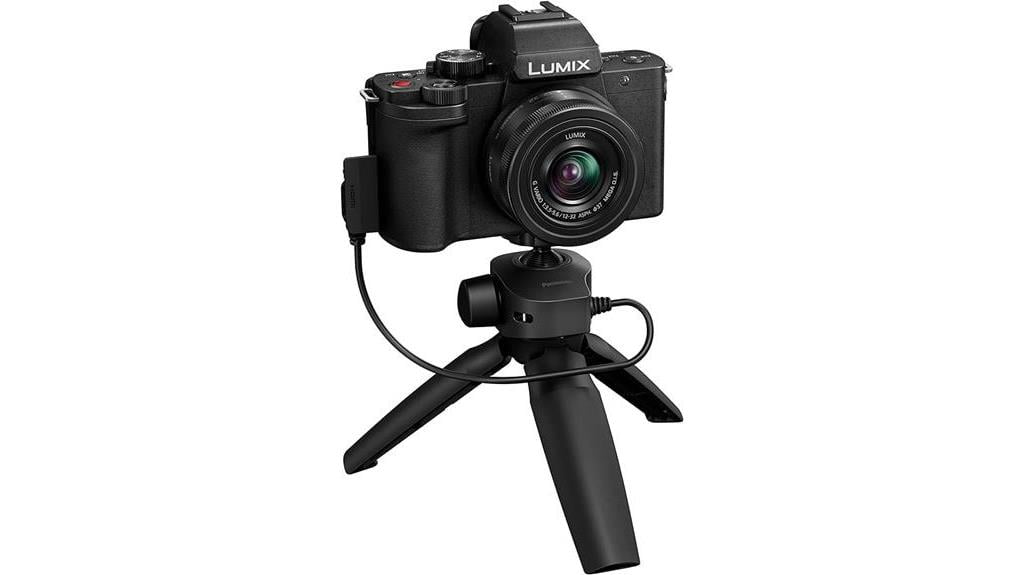
We highly recommend the Panasonic LUMIX G100 for podcasting due to its exceptional features and functionality. As a lightweight and portable mirrorless camera, it’s perfect for podcasters on the go. The LUMIX G100 captures crystal-clear 4K photo and video, ensuring that your podcast episodes will have a professional look and feel. It also integrates seamlessly with smartphones, allowing for easy sharing and editing. With its built-in microphone and high-quality spatial audio recording, you can be confident that your podcast’s sound will be top-notch. Additionally, the camera’s compact size and advanced image stabilization make it easy to handle during recording sessions.
Product Specs:
- Micro Four Thirds with 12-32mm lens
- 5-Axis Hybrid I.S for image stabilization
- 4K 24p/30p video recording
- Intuitive frame marker for social media aspect ratios
- Facial recognition
- V-Log L recording for editing freedom
- REC Frame Indicator for easy recording
- Lightweight and easy to carry
- Connects to computer for use as a webcam
- 360-degree sound recording
Pros:
- Lightweight and portable design
- Crystal-clear 4K photo and video quality
- Seamless integration with smartphones for easy sharing and editing
- Built-in microphone and high-quality spatial audio recording
- Compact size and advanced image stabilization for easy handling
Cons:
- Lack of Webcam capability
- EVF lacking in quality
- Dainty size and switch operation may not be suitable for all users
Canon EOS Rebel T7
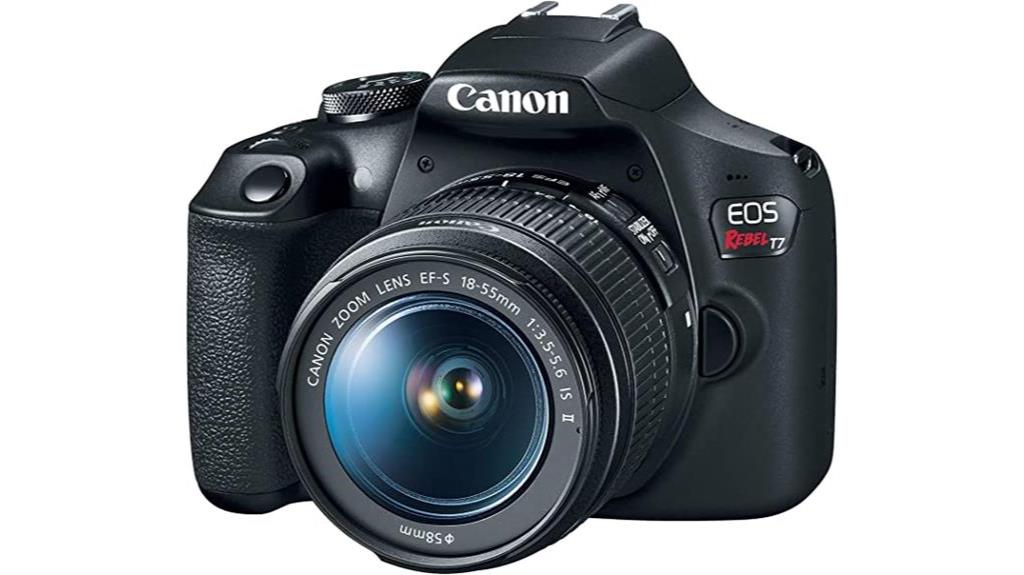
Let’s dive into why the Canon EOS Rebel T7 is one of the best cameras for podcasting.
The Canon EOS Rebel T7 DSLR Camera with 18-55mm Lens boasts a 24.1 Megapixel CMOS sensor and an ISO range of 100-6400 (H: 12800), allowing you to capture high-quality images even in low-light situations. With built-in Wi-Fi and NFC technology, you can easily transfer your podcast footage to your computer or upload it directly to your preferred platform. The 9-Point AF system and AI Servo AF ensure that your subject stays sharp and in focus, while the full HD video capability lets you record your podcast in stunning detail.
Product Specs:
- 24.1 Megapixel CMOS sensor
- ISO range of 100-6400 (H: 12800)
- Built-in Wi-Fi and NFC technology
- 9-Point AF system and AI Servo AF
- Full HD video capability
Pros:
- Affordable pricing
- Decent image quality
- Compact and lightweight
- User-friendly interface
Cons:
- Mediocre low-light performance
- Limited features
- Slow autofocus
- Limited video capabilities
- Average build quality
Panasonic HC-VX981K: Best cameras for liv
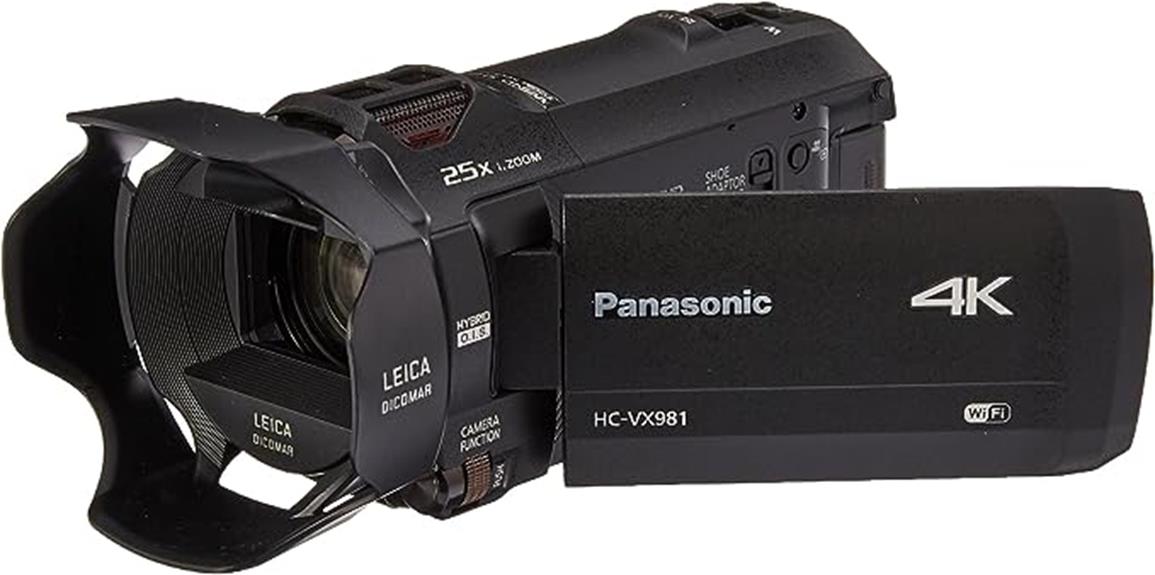
After researching various options, our team found that the Panasonic HC-VX981K is one of the best cameras for podcasting. This camera offers a range of features and specifications that make it ideal for capturing high-quality video and audio content.
The Panasonic HC-VX981K boasts a 20X optical zoom and a 1/2.3-inch BSI sensor, ensuring clear and detailed footage. It also features HDR capture, which enhances the dynamic range of your videos. Additionally, the camera offers Wi-Fi smartphone multi-scene video capture, allowing you to control and monitor your recordings remotely.
Some of the key pros of the Panasonic HC-VX981K include its 4K Ultra HD recording capability, in-camera editing features, and wireless twin camera functionality. The camera also has a 5-axis Hybrid O.I.S. for image stabilization and a high-resolution 18.91-megapixel MOS sensor.
However, it’s important to note a few cons of the Panasonic HC-VX981K. Some users have reported that the camera’s low-light performance could be improved, and the touch screen interface may not be as intuitive as desired. Additionally, the camera’s size and weight may be a drawback for those looking for a more compact option.
Product specs:
- 20X optical zoom
- 1/2.3-inch BSI sensor
- HDR capture
- Wi-Fi smartphone multi-scene video capture
- 18.91-megapixel MOS sensor
Pros:
- 4K Ultra HD recording
- In-camera editing features
- Wireless twin camera functionality
- 5-axis Hybrid O.I.S.
- High-resolution sensor
Cons:
- Low-light performance could be improved
- Touch screen interface may not be intuitive
- Size and weight of the camera
Sony ZV-E10
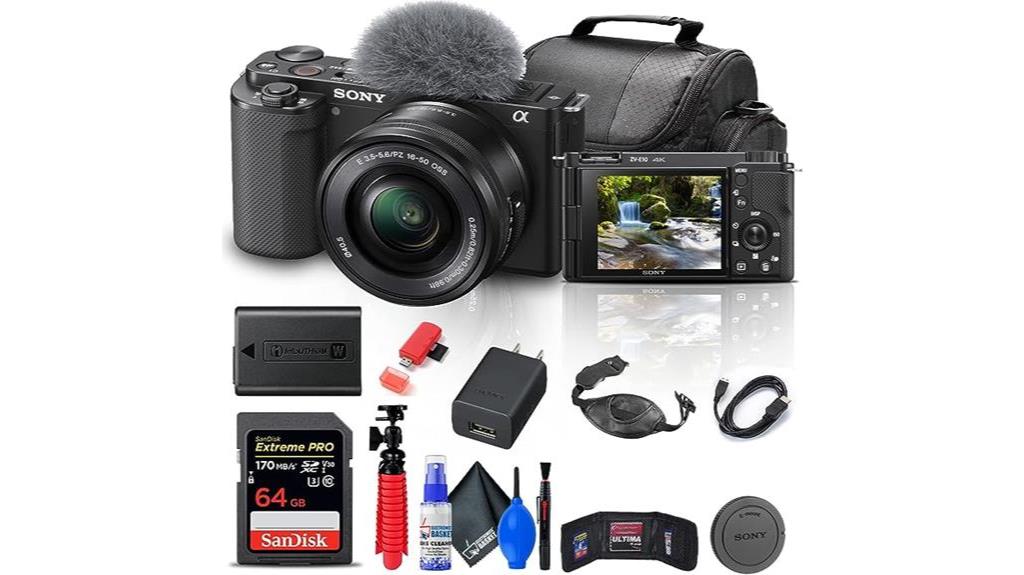
The Sony ZV-E10 is a versatile mirrorless camera that offers excellent features for podcasting. With its large APS-C sensor and mirrorless versatility, this camera allows for improved image quality and a greater choice of lenses. It’s specifically designed with a specialized feature-set for content creators, including shooting modes like background defocus and product showcase. The vari-angle screen ensures accurate framing, while the integrated directional mic captures accurate sound.
Additionally, the camera boasts a 24.2MP APS-C Exmor CMOS sensor, UHD 4K30P and Full HD 120P video recording capabilities, and a 3.0 side flip-out touchscreen LCD. The 425-point fast hybrid AF system and ISO range of 100-32000 further enhance the camera’s performance.
Overall, the Sony ZV-E10 is a reliable option for podcasting.
Product Specs:
- 24.2MP APS-C Exmor CMOS sensor
- UHD 4K30P and Full HD 120P video recording
- 3.0 side flip-out touchscreen LCD
- 425-point fast hybrid AF system
- Vari-angle screen
Pros:
- Large APS-C sensor for improved image quality
- Versatile shooting modes for content creators
- Integrated directional mic for accurate sound recording
- Flip-out touchscreen LCD for easy framing
- Fast hybrid AF system for quick and precise focusing
Cons:
- Limited lens options compared to full-frame cameras
- No in-body image stabilization
- Limited low-light performance compared to higher-end models
OLYMPUS E-M10
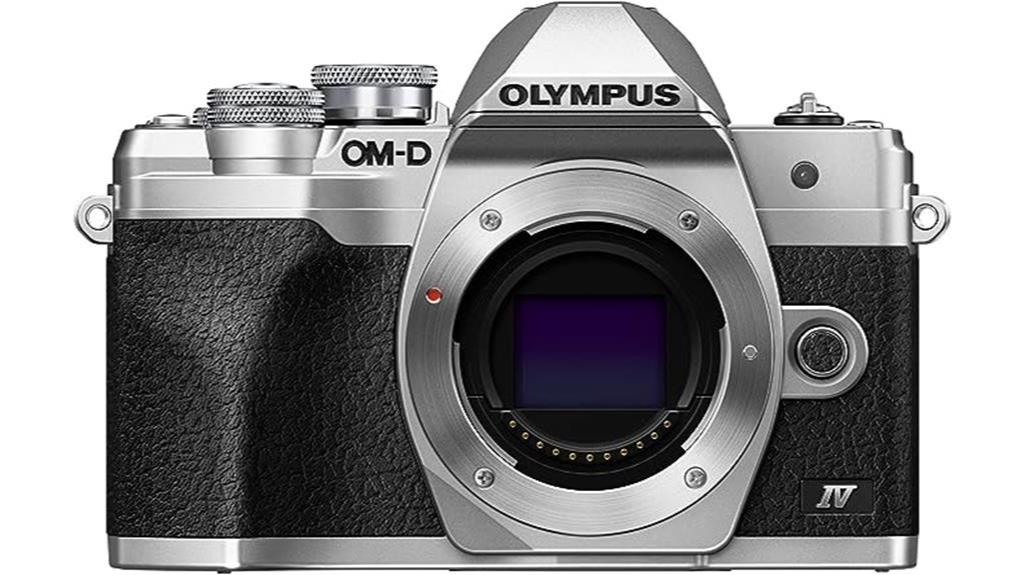
We highly recommend the OLYMPUS E-M10 as one of the best cameras for podcasting due to its exceptional image quality and user-friendly features. The OLYMPUS E-M10 Mark IV Silver Micro Four Thirds System Camera boasts a 20 MP Live MOS Sensor and 5-axis image stabilization, ensuring clear and stable footage. With 4K video capabilities and Wi-Fi and Bluetooth connectivity, it offers versatility and ease of use for podcasters. The flip-down monitor and dedicated selfie mode make it convenient for solo podcasting or vlogging. Additionally, the camera offers 16 Art Filters to enhance creativity and add unique effects to your videos.
Product Specs:
- OLYMPUS E-M10 Mark IV Silver Micro Four Thirds System Camera
- 20 MP Live MOS Sensor
- 5-Axis Image Stabilization
- 4K Video
- Wi-Fi and Bluetooth connectivity
- Flip-down monitor and dedicated selfie mode
- 16 Art Filters
Pros:
- Exceptional image quality
- User-friendly features
- 4K video capabilities
- Wi-Fi and Bluetooth connectivity
- Flip-down monitor and dedicated selfie mode
- 16 Art Filters for creative effects
Cons:
- Limited negative feedback regarding charging limitations, EVF activation, battery door, autofocus, and lack of articulating EVF
Panasonic LUMIX FZ80
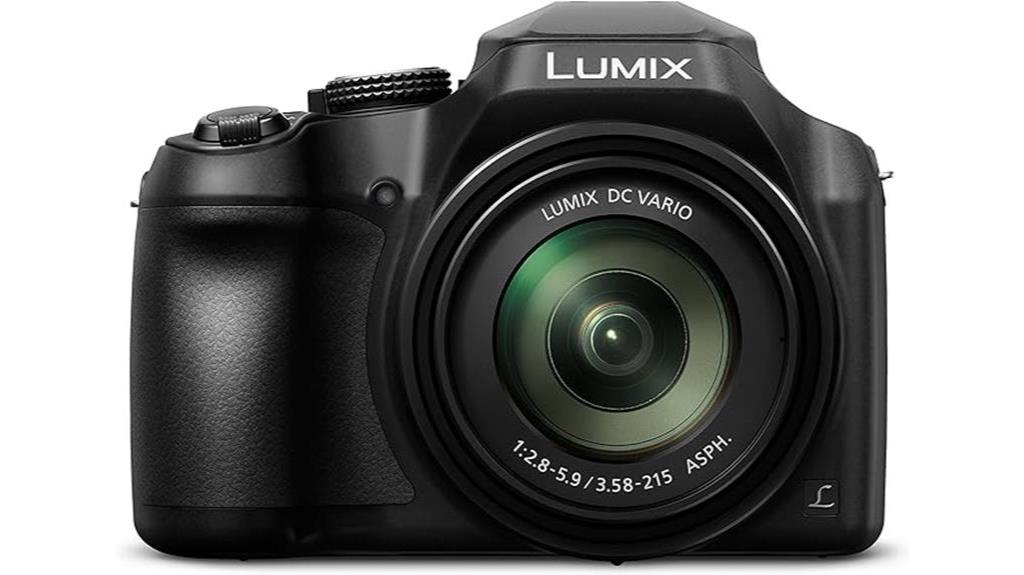
Let’s explore the Panasonic LUMIX FZ80, one of the best cameras for podcasting, and its impressive features for capturing high-quality footage.
The LUMIX FZ80 boasts an 18.1 megapixel MOS sensor and a powerful 60X zoom DC Vario lens, allowing you to capture stunning details even from a distance. The camera is equipped with Power O.I.S. technology, ensuring your footage remains stable and shake-free, while the high resolution 1,170K dot viewfinder and rear touch enabled 3-inch LCD display provide a clear and convenient viewing experience.
With 4K QFHD video recording capabilities, you can create professional-looking videos for your podcast. Additionally, the LUMIX FZ80 offers low light capture capabilities and features like USB charging and Wi-Fi connectivity for added convenience.
Product Specs:
- 18.1 megapixel MOS sensor
- 60X zoom DC Vario lens (20-1220mm)
- Power O.I.S. (Optical Image Stabilizer)
- High resolution 1,170K dot viewfinder
- Rear touch enabled 3-inch LCD display (1040 dots)
- 4K QFHD video recording (3840 x 2160)
- Low light capture capabilities
- USB charging and Wi-Fi connectivity
Pros:
- Impressive zoom capabilities
- High-quality image and 4K video
- Convenient USB charging and Wi-Fi connectivity
Cons:
- Limited battery life
- Image stabilization could be improved
- Mixed performance in low light conditions
Nikon COOLPIX B500: Best Camera for Podcast
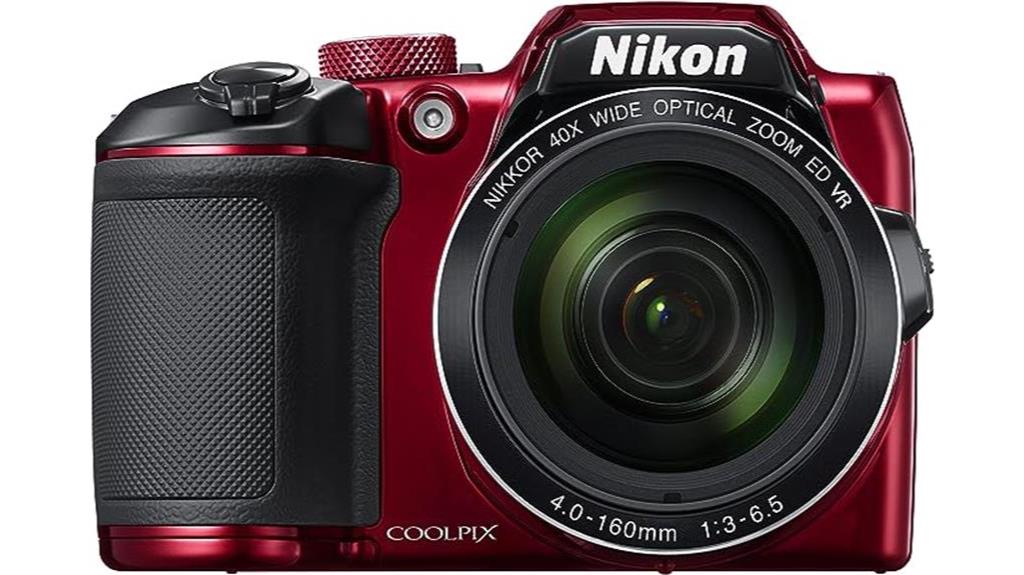
We highly recommend the Nikon COOLPIX B500 for podcasting due to its impressive features and user-friendly design.
With a 16 megapixel low-light sensor and Lens-Shift Vibration Reduction (VR), this camera ensures high-quality images and steady videos. The easy menus and controls make it simple to navigate, while the fun creative effects allow for added versatility and creativity.
The 40x optical zoom and 80x Dynamic Fine Zoom enable close-up shots without sacrificing image quality. Additionally, the tilting 3.0-inch LCD screen and Full HD 1080p video capability with stereo sound enhance the overall podcasting experience.
The built-in Wi-Fi, NFC, and Bluetooth low energy (BLE) connectivity options make it easy to share photos and videos instantly or control the camera remotely. Overall, the Nikon COOLPIX B500 is a reliable choice for podcasters.
Product Specs:
- 16 megapixel low-light sensor
- Lens-Shift Vibration Reduction (VR)
- 40x optical zoom, 80x Dynamic Fine Zoom
- Tilting 3.0-inch 921,000-dot LCD
- Full HD 1080p videos with stereo sound
- Built-in Wi-Fi, NFC, and Bluetooth low energy (BLE)
Pros:
- User-friendly menus and controls
- Fun creative effects for added versatility
- High-quality images and steady videos
- Easy sharing and remote camera control with smartphone connectivity
- Tilting LCD screen for flexible shooting angles
Cons:
- Limited manual control options
- Average battery life
- No external microphone input
Logitech Brio 4K
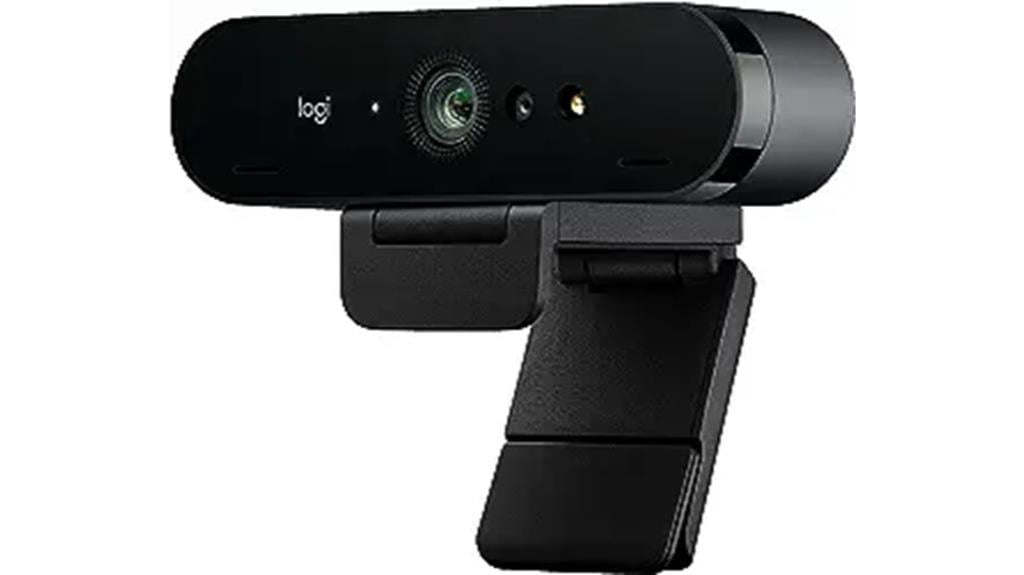
The Logitech Brio 4K is an excellent choice for podcasting due to its impressive 4K Ultra HD video quality and versatile compatibility with various video conferencing platforms. With its stunning video resolution, the Logitech Brio 4K ensures that your podcast episodes are visually captivating and professional-looking. The auto light adjustment feature with Logitech RightLight 3 guarantees optimal visibility in any lighting condition, making your videos consistently clear and well-lit.
The wide field of view presets allow for flexibility in capturing group calls or showcasing your surroundings, adding depth and context to your podcast episodes. Additionally, the Logitech Brio 4K comes with dual omni-directional microphones with noise-canceling technology, delivering clear and crisp audio to your listeners. Its compatibility with popular video conferencing platforms such as Microsoft Teams, Zoom, and Google Voice makes it easy to connect and record podcasts with ease.
Product Specs:
- Ultra 4K HD resolution
- Auto light adjustment with Logitech RightLight 3
- Noise-canceling technology with dual omni-directional mics
- 3 field of view presets
- Up to 90 fps
- Windows Hello integration
- Privacy shutter
- Premium build quality
- Multiple mounting options
Pros:
- Stunning 4K Ultra HD video quality
- Auto light correction for optimal visibility in any lighting condition
- Wide field of view for group calls or capturing surroundings
- Clear and crisp audio with noise-canceling microphone
- Versatile compatibility with various video conferencing platforms
- Privacy shutter for added security
- Exceptional value for the price
Cons:
- Serviceable but not great noise-canceling microphones
- USB A cable requiring an adapter for USB C computers
- Inability to save default resolution and field of view settings
- Limited tilting options once mounted on a monitor
AVerMedia Live Streamer Cam 313
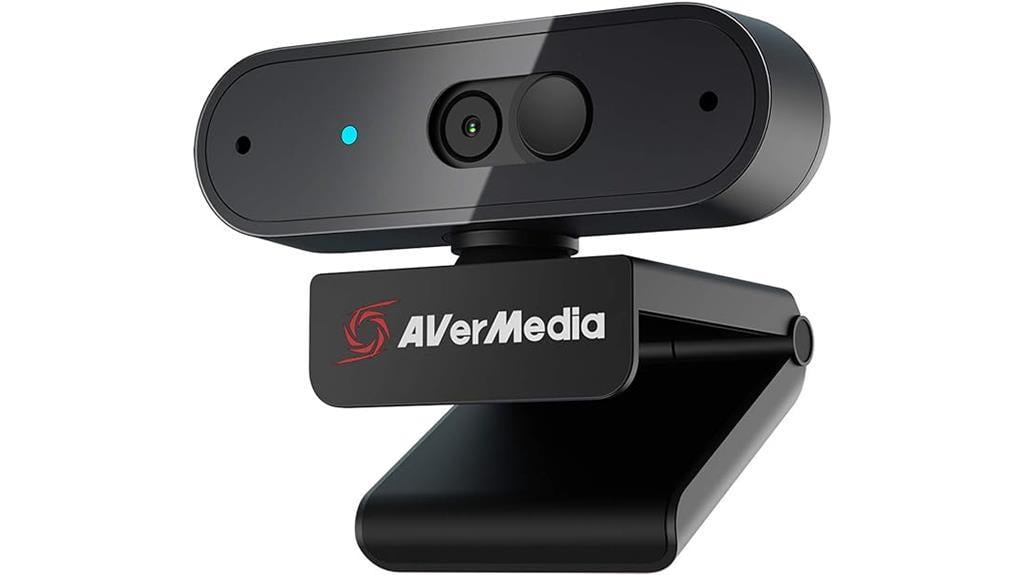
We found that the AVerMedia Live Streamer Cam 313 is a reliable option for podcasting due to its impressive video quality and convenient features. This webcam offers full HD 1080p video at 30fps, ensuring sharp and clear visuals for your podcast recordings. The autofocus and video setting adjustments allow you to fine-tune the image to your liking, while the dual stereo microphones capture clear and crisp audio. The built-in privacy shutter provides peace of mind when not in use. Additionally, the AVerMedia Live Streamer Cam 313 is compatible with various operating systems and video apps, making it versatile for different setups. Overall, this webcam offers excellent performance and functionality for podcasting.
Product Specs:
- Full HD 1080p video at 30fps
- Autofocus and video setting adjustments
- Dual Stereo Microphones
- Built-in privacy shutter
- Compatible with various operating systems and video apps
- Mounting type: Swivel Tripod Clip
- Optical sensor resolution: 1.0 megapixels
- Product dimensions: 3.4 x 1.9 x 1.9 inches
- Item weight: 8.8 ounces
- Color: Black
- Special features: Privacy Shutter, Swivel Tripod Clip : 360° Pan, 1/4 Thread
- Best Sellers Rank: #677 in Webcams
- Date First Available: January 8, 2021
Pros:
- Impressive video quality
- Autofocus and video setting adjustments for customization
- Dual stereo microphones for clear audio
- Built-in privacy shutter for added security
- Compatible with various operating systems and video apps
Cons:
- Requires good lighting for optimal image quality
- Fixed focus may not suit all preferences
- Some users reported blurry image and lack of autofocus in certain cases.
What Should You Consider Before Buying A Podcast Video Camera?
Before purchasing a podcast video camera, there are several important factors to consider. These include:
- The camera’s resolution
- Frame rate
- Recording limit
- Autofocus capabilities
- Image stabilization
We need to examine these points in more detail to ensure we choose the best camera for our podcasting needs.
Resolution
As we delve into the topic of resolution, there are several factors to consider before purchasing a podcast video camera. The resolution of a camera for podcasting determines the level of detail and clarity in your videos. Higher resolution cameras produce sharper and more detailed images, resulting in better video quality. When choosing a video camera, it is important to consider the resolution that best suits your needs. Here is a table comparing different resolutions and their corresponding video quality:
| Resolution | Video Quality |
|---|---|
| 720p | Good |
| 1080p | High |
| 4K | Excellent |
| 8K | Superior |
| 12K | Exceptional |
Frame rate
When it comes to buying a podcast video camera, one of the factors we need to consider is the frame rate. The frame rate refers to the number of frames that the camera captures per second. A higher frame rate allows for smoother and more fluid motion in your videos.
Here are some important things to consider when it comes to frame rate:
- Smoothness: A higher frame rate, such as 60fps, can help eliminate any judder or choppiness in your videos.
- Slow motion: If you plan on shooting slow-motion footage for your podcast, a higher frame rate, such as 120fps or 240fps, is essential.
- Editing flexibility: A higher frame rate gives you more flexibility in post-production, allowing you to slow down or speed up your footage without losing quality.
- Compatibility: Make sure the camera you choose supports the frame rate you want to shoot at, as not all cameras offer the same options.
When looking for the best camera for podcasting, consider the frame rate capabilities to ensure smooth and high-quality videos for your podcast.
Recording limit
With regards to purchasing a podcast video camera, one factor we should take into account is the recording limit, as it can significantly impact our recording sessions. The recording limit refers to the maximum duration of continuous video recording that a camera can handle in a single session. It is important to consider this aspect when choosing a camera for your podcast setup, especially if your podcast videos tend to be longer or if you plan on recording for extended periods of time. To help you make an informed decision, here is a comparison table of popular cameras for podcasting and their respective recording limits:
| Camera Model | Recording Limit |
|---|---|
| Camera A | 30 minutes |
| Camera B | 60 minutes |
| Camera C | No limit |
Autofocus
Autofocus is a crucial feature in a podcast camera setup, as it ensures that the subject stays sharp and in focus throughout the recording. When selecting the best camera for podcasting, consider the following:
- Fast and accurate autofocus: Look for a camera that offers quick and precise autofocus capabilities, allowing you to maintain a professional look during video podcasting.
- Face detection: This feature helps the camera recognize and focus on the host’s face, ensuring they remain the center of attention.
- Tracking autofocus: A camera with tracking autofocus can follow a moving subject, which is especially useful for podcasters who like to move around while recording.
- Manual focus override: Having the option to manually adjust focus if needed gives you more control over your video’s appearance.
Image stabilization
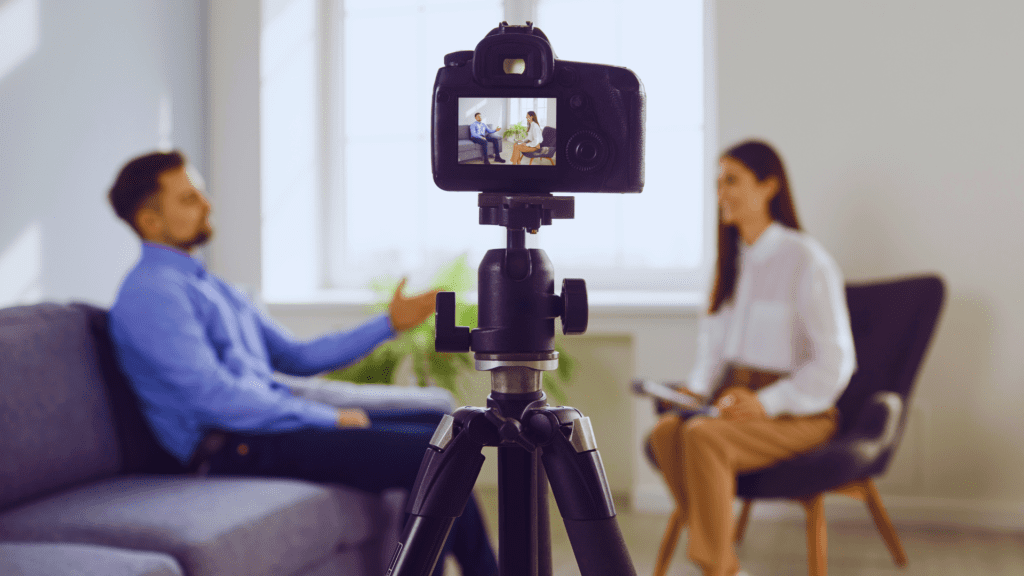
One important consideration before purchasing a podcast video camera is the effectiveness of its image stabilization. When it comes to creating professional-looking video podcasts, having steady footage is essential. Image stabilization technology minimizes camera shake and ensures smooth and steady shots, even when you’re moving or walking while recording.
The best cameras for podcasting offer advanced image stabilization features that can make a significant difference in the quality of your videos. Mirrorless cameras are known for their excellent image stabilization capabilities, thanks to their innovative sensor-shift technology. This technology compensates for any movement or vibrations to deliver clear and stable footage.
Whether you’re filming in a studio or on the go, investing in a camera with reliable image stabilization will greatly enhance the overall production value of your video podcast.
Battery life
We should prioritize considering battery life before purchasing a podcast video camera. When choosing the right camera for podcasting, it’s essential to have a camera with a long-lasting battery to ensure uninterrupted recording of your podcast.
Here are some key factors to consider regarding battery life:
- Battery capacity: Look for a camera with a high-capacity battery that can last for extended recording sessions.
- Battery type: Consider cameras with lithium-ion batteries, as they tend to provide longer battery life compared to other types.
- Power-saving features: Look for cameras that offer power-saving features, such as automatic sleep mode or adjustable screen brightness.
- External power options: Check if the camera has the option for external power sources, such as AC adapters or power banks, for longer recording sessions.
Considering these factors will help you choose a camera for podcasting that can meet your battery life requirements and ensure a seamless recording experience.
Audio quality
Two important factors to consider when buying a podcast video camera are the audio quality and the microphone options available. As podcasters, we understand the importance of clear and crisp audio in delivering our content to our audience. When it comes to podcasting setup, having the right podcast equipment, including a high-quality microphone for podcasting, is crucial. To help you make an informed decision, we have created a table outlining some popular cameras for podcasting and their audio capabilities:
| Camera Model | Audio Quality | Microphone Options |
|---|---|---|
| Canon EOS 80D | Excellent | External microphone input |
| Sony A6400 | Very Good | External microphone input |
| Panasonic Lumix GH5 | Excellent | External microphone input |
| Blackmagic Pocket Cinema Camera 4K | Excellent | External microphone input |
| GoPro Hero 9 Black | Good | Built-in microphone with optional external microphone input |
Best Cameras for Podcasting: FAQs
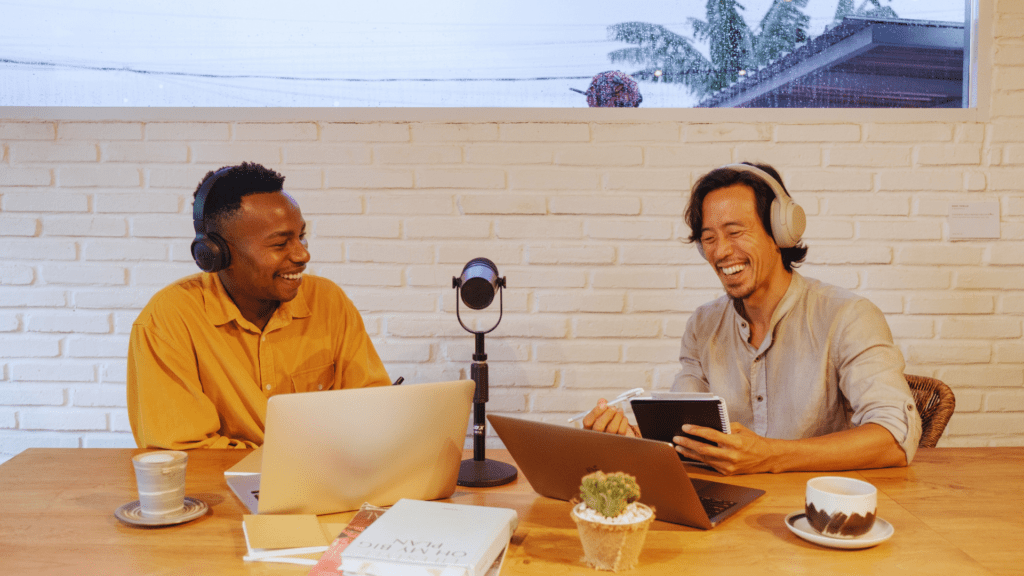
Can I Use My Smartphone as a Podcasting Camera?
Yes, we can use our smartphones as podcasting cameras. They offer decent video quality and are convenient to use. However, for professional results, dedicated cameras with better lenses and features are recommended.
What Is the Ideal Resolution for a Podcasting Camera?
The ideal resolution for a podcasting camera depends on various factors such as the platform and audience preferences. We should consider factors like video quality, file size, and streaming capabilities before determining the best resolution for our podcast.
How Important Is Low-Light Performance in a Podcasting Camera?
Low-light performance is paramount for podcasting cameras. It enhances the overall quality and allows for flexibility in various recording environments. Lackluster lighting can be a major distraction, so investing in a camera with excellent low-light capabilities is key.
Can I Connect an External Microphone Directly to the Camera?
Yes, we can connect an external microphone directly to the camera. It allows us to improve the audio quality of our podcast and eliminates the need for separate audio recording equipment.
Are Mirrorless Cameras Better Suited for Podcasting Than Dslrs?
Mirrorless cameras are generally better suited for podcasting than DSLRs. They are more compact, lighter, and offer great video quality. Additionally, they often have features like flip-out screens and built-in microphones, making them convenient for podcasting on the go.
What are the best cameras for podcasting?
If you’re looking for the best cameras for podcasting, there are several options to consider. Some popular choices include the webcams for podcasting which offers excellent video quality and is great for capturing high-quality video and audio during podcast recordings. Another top pick is the best camera for podcasting, which provides 4K video recording capabilities and is perfect for enhancing your podcast videos.
Are there any recommended cameras for live streaming during podcast recordings?
Absolutely! If you plan to live stream your podcast recordings, there are cameras specifically designed for live streaming. Take a look at cameras like the cameras for live streaming , which are equipped with features that optimize the streaming experience. These cameras provide high-quality video output and are ideal for engaging your audience during live podcast sessions.
What is the advantage of using a 4K video camera for podcasting?
Using a 4K video camera for podcasting offers several advantages. Firstly, it allows you to capture your podcast recordings in stunningly sharp resolution, which adds a professional touch to your content. Additionally, recording in 4K provides you with more flexibility during the editing process, as you can zoom in without sacrificing video quality. Overall, a 4K video podcasting camera enhances the visual appeal and overall experience of your podcast.
Conclusion
In conclusion, when it comes to podcasting, finding the best camera is crucial for creating high-quality videos. With a wide range of options available, it’s important to consider factors like video resolution, audio quality, and ease of use.
So, don’t settle for anything less than the top-notch cameras mentioned in this article. They’ll take your podcasting game to the next level, capturing every detail with such brilliance that your audience will be left awestruck.

